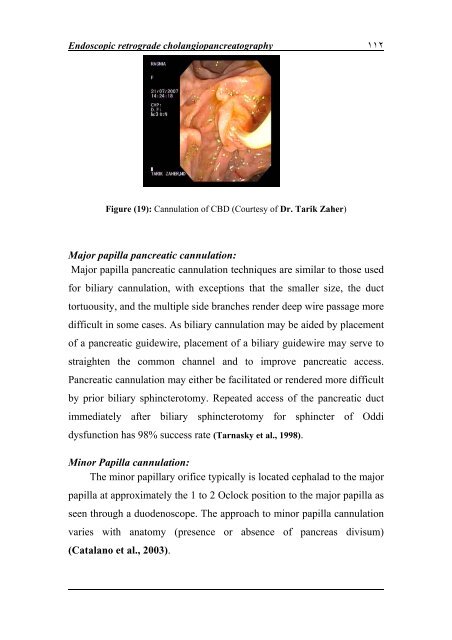- Page 1 and 2:
Parasites and Biliary stones Essay
- Page 3 and 4:
Dedication TO MY BELOVED DEAR MOTHE
- Page 5 and 6:
Abstract Gall stone disease remains
- Page 7 and 8:
MTBE : ML : Methyl tertiary butyl e
- Page 9 and 10:
Figure (14): Cystic echinococcosis:
- Page 11:
List of tables Table (1): Diagnosis
- Page 14 and 15:
Introduction ٢ Clonorchis sinensis
- Page 16 and 17:
Billiary parasites ٤ Billiary para
- Page 18 and 19:
Billiary parasites ٦ Treatment: Fi
- Page 20 and 21:
Ascariasis ٨ Ascariasis Ascariasis
- Page 22 and 23:
Ascariasis ١٠ migration. Symptoms
- Page 24 and 25:
Ascariasis ١٢ conditions, includi
- Page 26 and 27:
Fascioliasis ١٤ (Acuna-Soto and B
- Page 28 and 29:
Fascioliasis ١٦ can demonstrate p
- Page 30 and 31:
Fascioliasis ١٨ which is more phy
- Page 32 and 33:
Fascioliasis ٢٠ Figure (5): ERCP
- Page 34 and 35:
Clonorchiasis ٢٢ Clonorchiasis Cl
- Page 36 and 37:
Clonorchiasis ٢٤ correlate with t
- Page 38 and 39:
Clonorchiasis ٢٦ end is broad and
- Page 40 and 41:
Clonorchiasis ٢٨ 2003). Ultrasono
- Page 42 and 43:
Clonorchiasis ٣٠ The main indicat
- Page 44 and 45:
Opisthorchiasis ٣٢ Life cycle: Th
- Page 46 and 47:
Opisthorchiasis ٣٤ periductal fib
- Page 48 and 49:
Opisthorchiasis ٣٦ (Sirisinha, 19
- Page 50 and 51:
Dicrocoeliasis ٣٨ ganglion (brain
- Page 52 and 53:
Dicrocoeliasis ٤٠ assay for egg d
- Page 54 and 55:
Echinococcosis ٤٢ Echinococcosis
- Page 56 and 57:
Echinococcosis ٤٤ Adult worm infe
- Page 58 and 59:
Echinococcosis ٤٦ metacestodes in
- Page 60 and 61:
Echinococcosis ٤٨ Figure (15) (a)
- Page 62 and 63:
Echinococcosis ٥٠ relapsed after
- Page 64 and 65:
Cryptosporidiosis ٥٢ Cryptosporid
- Page 66 and 67:
Cryptosporidiosis ٥٤ malnutrition
- Page 68 and 69:
Cryptosporidiosis ٥٦ levels. If t
- Page 70 and 71:
Giardiasis ٥٨ the alkaline, prote
- Page 72 and 73:
Giardiasis ٦٠ diagnosis must be c
- Page 74 and 75: Giardiasis ٦٢ used for 14 days (B
- Page 76 and 77: Gallbladder stones ٦٤ stage is es
- Page 78 and 79: Gallbladder stones ٦٦ Complicatio
- Page 80 and 81: Gallbladder stones ٦٨ 25% within
- Page 82 and 83: Choledocholithiasis ٧٠ encountere
- Page 84 and 85: Choledocholithiasis ٧٢ The sympto
- Page 86 and 87: Choledocholithiasis ٧٤ Patients w
- Page 88 and 89: Choledocholithiasis ٧٦ and ERCP (
- Page 90 and 91: Choledocholithiasis ٧٨ Figure (16
- Page 92 and 93: Treatment of calcular obstructive j
- Page 94 and 95: Treatment of calcular obstructive j
- Page 96 and 97: Treatment of calcular obstructive j
- Page 98 and 99: Hepatolithiasis ٨٦ aerobes, sugge
- Page 100 and 101: Hepatolithiasis ٨٨ Clinical pictu
- Page 102 and 103: Hepatolithiasis ٩٠ dilatation). T
- Page 104 and 105: Hepatolithiasis ٩٢ Hepatic resect
- Page 106 and 107: Relationship between Ascaris and bi
- Page 108 and 109: Relationship between clonorchis sin
- Page 110 and 111: Relationship between opisthorchiasi
- Page 112 and 113: Relationship between Echinococcosis
- Page 114 and 115: Endoscopic retrograde cholangiopanc
- Page 116 and 117: Endoscopic retrograde cholangiopanc
- Page 118 and 119: Endoscopic retrograde cholangiopanc
- Page 120 and 121: Endoscopic retrograde cholangiopanc
- Page 122 and 123: Endoscopic retrograde cholangiopanc
- Page 126 and 127: Endoscopic retrograde cholangiopanc
- Page 128 and 129: Endoscopic retrograde cholangiopanc
- Page 130 and 131: Endoscopic retrograde cholangiopanc
- Page 132 and 133: Endoscopic retrograde cholangiopanc
- Page 134 and 135: Endoscopic retrograde cholangiopanc
- Page 136 and 137: Endoscopic retrograde cholangiopanc
- Page 138 and 139: Endoscopic retrograde cholangiopanc
- Page 140 and 141: Endoscopic retrograde cholangiopanc
- Page 142 and 143: Endoscopic retrograde cholangiopanc
- Page 144 and 145: Endoscopic retrograde cholangiopanc
- Page 146 and 147: Endoscopic retrograde cholangiopanc
- Page 148 and 149: Endoscopic retrograde cholangiopanc
- Page 150 and 151: Summary and conclusion ١٣٨ Paras
- Page 152 and 153: References ١٤٠ Aliperti G. (1996
- Page 154 and 155: References ١٤٢ Badie, A. and Rod
- Page 156 and 157: References ١٤٤ Binmoeller KF, Se
- Page 158 and 159: References ١٤٦ Campo R, Manga-Go
- Page 160 and 161: References ١٤٨ Cheung KL and Lai
- Page 162 and 163: References ١٥٠ Costamagna G, Sha
- Page 164 and 165: References ١٥٢ Ditrich O, Palkov
- Page 166 and 167: References ١٥٤ Elkins DB, Mairia
- Page 168 and 169: References ١٥٦ Flanagan PA. (199
- Page 170 and 171: References ١٥٨ Giurgiu DIN and R
- Page 172 and 173: References ١٦٠ Harinasuta C and
- Page 174 and 175:
References ١٦٢ Hixson LJ, Fenner
- Page 176 and 177:
References ١٦٤ Jastak JT and Pes
- Page 178 and 179:
References ١٦٦ Kaufman HS, Magnu
- Page 180 and 181:
References ١٦٨ Koumanidou C, Man
- Page 182 and 183:
References ١٧٠ Leung J, Sung JY,
- Page 184 and 185:
References ١٧٢ Lujan HD, Mowatt
- Page 186 and 187:
References ١٧٤ Menghebat L, Jian
- Page 188 and 189:
References ١٧٦ Nagano I, Pei F,
- Page 190 and 191:
References ١٧٨ relationship to t
- Page 192 and 193:
References ١٨٠ Ponchon T, Gagnon
- Page 194 and 195:
References ١٨٢ Rim HJ, Lyu KS, L
- Page 196 and 197:
References ١٨٤ Sato T, Suzuki N,
- Page 198 and 199:
References ١٨٦ Shemesh E, Czerni
- Page 200 and 201:
References ١٨٨ Stapfer M, Selby
- Page 202 and 203:
References ١٩٠ sphincterotomy in
- Page 204 and 205:
References ١٩٢ Upatham ES, Brokl
- Page 206 and 207:
References ١٩٤ Wermke W and Borg
- Page 208 and 209:
References ١٩٦ ProspecT Giardia
- Page 210 and 211:
تﺎﻗﺎﻨﺘﺧﻹا ﻦﻳﻮ
- Page 212:
ﺔﻳراﺮﻤﻟا تاﻮﺼﺤ
















